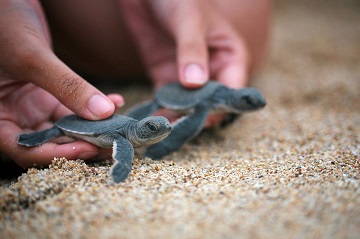A Group of IPB Researchers Designed Beach Tour on Green Turtle Conservation

Pangumbahan Beach in Sukabumi Regency, West Java, is designated as Coastal Park for green turtles (Chelonia mydas). Pengumbahan is a prolific giant green sea turtle nesting beach, which is named Penyu Pangumbahan Beach. The Pangumbahan area is surrounded by forests with sightings of Macaques, Leaf Monkeys, Wild Boars, Otters, Monitor Lizards and birds like the Kingfisher, Herons, Eagles and forest species like Pigeons, Fantails and Sunbirds. The number of green turtles come to lay eggs at Pangumbahan beach has declined, as they are being exploited for meat, eggs, traditional medicine, and pet trade. The utilization of the area as a turtle tourism should be considered, as the green turtle is a rare species that must be protected. Therefore, it is necessary to conserve the green turtle population by developing ecotourism area.
With reference to the current issue sated above, a number of experts from the Department of Water Resources Management of the Faculty of Fisheries and Marine Sciences of Bogor Agricultural University (FPIK IPB), i.e. Neneng Nurbaeti, Fredinan Yulianda and Achmad Fahrudin implemented the research program on the management of coastal tourism based on the conservation of green turtles in Pangumbahan.
Fredinan said the green turtle population has declined in Indonesia, including in Pangumbahan Beach. The declined is caused by natural factors and human activities. Threats to turtles can be classified as natural and human-related. “Natural threats include beach land erosion, predators like monitor lizards and dogs preying on their nests, and rising sea levels. Human threats include advancements in fishing technology, development in coastal areas, increase in leisure activities around nest areas and turtle consumption. Human eating habits are a factor, as people eat turtle eggs and meat. Turtle shells are also used as ornaments., Thus, they are classified as endangered as Green turtles are threatened by overharvesting of their eggs, hunting of adults, being caught in fishing gear and loss of nesting beach sites. Efforts to improve knowledge and techniques, as well as enhanced management to increase the number green turtle eggs produced, hatched and successfully released as hatchlings are on going.
Taman Pusir Pantai Penyu Pangumbahan is one form of Water Conservation Area, Coastal and Small Islands (KKP3K) stipulated by the Decree of the Regent Number 523 / Kep.639Dislutkan / 2008. The diversion of exploitation activities on green turtles into recreational activities into coastal ecotourism. Determination of the area is expected to ensure the sustainability of turtle populations ecologically, and change the public perception that the conservation area is closed area (the prohibited area) for pubic.
"Social and economic aspects of this conservation program will provide maximum benefits for the welfare of the community. However the protection aspect for green turtle is applicable," said Fredinan
The research of IPB team revealed that not all conservation areas are appropriate for the nesting ground for green turtle. If sea turtles cannot survive and reproduce on their own, without help from humans, then they are doomed. Feeding and nesting grounds must be protected, and a public wildlife conservation ethic must be fostered that can withstand gaps in government regulations, pressure from private interests, and changes in the political climate. It is necessary to limit number of visitors to be adjusted into the carrying capacity of the area to maintain the authenticity of resources, keeping the comfort of green turtles and tourists. It is suggested the total number of visitors to coastal tourism activities should be around 119 visitors and sea turtle tourism should be 18 only. Although the concept of a social safe minimum standard analysis, as applied to the sustainability of tourism-dependent turtle watching, has focused on beach-nesting habitats. Then the development of the area for coastal tourism should be tailored to the potential of existing natural resources, their total number should not exceeding the carrying capacity of the region. (Wied)



